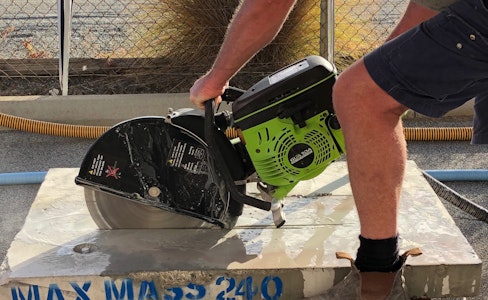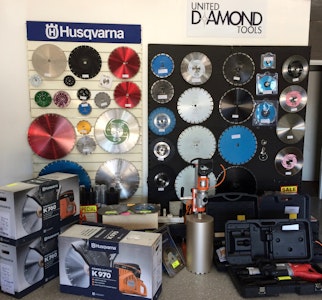Using your Diamond Blade
It would be almost impossible to outline all operating and safety procedures to suit all saws on all work sites in all conditions.
However, here are a range of factors you need to consider when using diamond tools.
These guidelines are not exhaustive. If in doubt on any issues, contact your site supervisor, the saw manufacturer, the blade manufacturer or your local Occupational Health and Safety Commission.
Preparation:
- Read your saw manual that came with the machine!
- Identify onsite hazards and plan to control the risks they present
- Operate in an uncluttered environment with no flammable or combustible objects near by
- Have a plan of what you are going to cut. Is there any rebar, sewer lines, electrical lines or gas lines where you will be cutting? Check again you are cutting in the right spot.
- If stressed components or components affecting the integrity of a building are damaged during cutting, operators can be at serious risk.
- Ensure you have selected the right type of blade, correctly sized for your machine, for the material you are cutting, the type of machine you are using and it's horsepower, and the speed of cutting you need. If in doubt, contact the saw or blade manufacturers.
- Check the blade for any damage
- Disconnect the machine from power, or ensure the engine is fully switched off, before changing a blade.
- Make sure the saw is in correct working order (with all safety guards in place), and will be safely operated by trained users
- Ensure the blade is mounted in the correct direction. If your blade does not have a direction indication on it, you should be able to see a "comet tail" behind exposed diamonds if the blade was "broken in" at the factory. This indicates the rotation - the tail should be behind the comet.
- Ensure the blade is mounted firmly. Check the mounting flanges are equal diameter, and do not have excess wear or flatness.
If using adaptors on the centre hole, ensure they are clean and cannot come loose and allow the blade to wobble - Make sure the blade has adequate water cooling on both sides of the blade. Do not cut dry
- Do a trial run before use to ensure the blade is installed correctly and not vibrating
- Do not use electric saws for wet cutting, unless specified as suitable by the manufacturer.
- Do not use hand held saws for inverted cutting
- Ensure adequate ventilation is allowed for petrol or diesel powered saws
- Ensure adequate collection of hazardous dust as per local legislation
- Ensure the user is wearing appropriate personal protective equipment (PPE) eg hearing protection, safety eye wear, dust mask, work boots, gloves, dust/slurry control measures etc. Consider using a PAPR (powered air purifying respirator). For more info on silica, see Safe Work Australia's info here.
- Ensure adequate lighting
- Plan for the removal of debris and rubble
- Have a fire extinguisher and first aid kit nearby
- Beware of sun damage to the operator
- When workers cut, crush, drill, polish, saw or grind products that contain silica, particles are created, which are one-hundredth of the size of a grain of sand. These can get stuck deep in the lungs. Ensure precautions to limit exposure to dust are in place.
See the WA government's info on silica dust here.
Positioning:
- Properly support and clamp the material being cut if necessary e.g. concrete pipe, to prevent pinched cuts
- Make sure there is an exclusion area around the cutting area adequate to keep other workers, general public and animals safe.
- Don't stand in direct line of the blade during start-up or operation.
- Be aware of the discharge area from the machine and do not allow yourself or others to enter that area. Remove items that could be damaged from this area.
- Never work off ladders, crates, drums or chairs. Always use proper access equipment if the work cannot be reached from the ground
- Hand held saws should not be operated above shoulder height or below knee level.
- Be aware concrete and masonry cutting and drilling equipment can be heavy, and the operator may be required to carry it around on site, then hold it in an awkward position for a long time. Use correct manual handling techniques.
- Adopt the correct grip and stance to control the saw
- Be aware of vibration fatigue and how to manage it
- Be aware of slippery floors, and unstable or uneven surfaces
- The risk of harm increases when working alone, even if you are just out of sight of other workers
Cutting:
- Always start your machine out of the cut, and only start cutting when full speed is achieved
- Allow the machine to run for thirty seconds before cutting to confirm correct mounting of the blade
- Open up the diamonds on a new blade with shallow cuts in soft, abrasive material (eg. limestone)
- For normal cutting, multiple shallow cuts (step cuts) are better than one single deep cut
- Be aware of the correct area of the blade to cut with to reduce kickback, pushback and pull in.
- Do not force the blade - allow the blade to do the work. Forcing or twisting the blade can cause bluntness, excessive wear, overheating, distortion and segment damage
- Do not side grind.
- Check the blade periodically for heat marks, cracks in the steel core or segments, or excessive wear underneath the segments
- Do not overheat the blade. If necessary, remove it momentarily from the cut to allow it to cool in the air
- If your slurry colour changes to brown or red, you are most probably cutting the dirt or sub base. This will wear your diamond blade quicker, so raise your blade.
- Don't allow the blade to deflect in the cut.
-
Don't attempt to cut curves unless the blade is specified for this. The result may be detached segments of the blade.
- Never leave running machines unattended
- If you're going to change directions on a floor saw, make sure your machine is off and the blade is up out of the cut before changing direction.
- If the blade glazes up, redress the blade by cutting an abrasive material like limestone, or our dressing stones, to remove some bond and expose diamonds so cutting can continue.
- Allow the machine and blade to stop rotating before placing machine down.
- Avoid touching a hot blade or machine
-
If dry cutting (not recommended) with suitable dust containment, only cut 25 - 50mm deep in a single pass. So a deeper cut may require several passes (this is called step cutting).
Remove the blade from the cut every 10 to 15 seconds at full speed to allow the air to cool the blade.
These guidelines are not exhaustive. If in doubt, contact the saw manufacturer, the blade manufacturer, site supervisor or local Occupational Health and Safety Commission.
Disclaimer: the information on this website is provided in good faith and believed to be reliable and accurate at this time. However, the information is provided on the basis that the reader will be solely responsible for assessing the information and its veracity and usefulness. UDT shall in no way be liable, in negligence or howsoever, for any loss sustained or incurred by anyone relying on the information, even if such information is or turns out to be wrong, incomplete, out-of-date or misleading.



